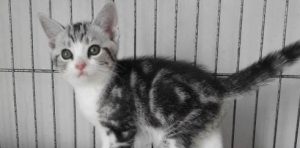Your American Shorthair has been compulsively scratching behind its ears for days. At first, you dismissed it as a quirky grooming habit—until you spotted a tiny black speck darting through its fur. This unsettling discovery marks the start of a silent war against Ctenocephalides felis, the common cat flea. What most owners don’t realize is that the fleas you see represent just 5% of an infestation; the remaining 95% lurk invisibly as eggs and larvae in your home. Beyond the itch lies a complex behavioral and biological puzzle: Why do fleas trigger obsessive scratching? How do their survival strategies exploit feline instincts? This article unravels the hidden warfare between cats and fleas, offering science-backed solutions to restore peace.

Decoding Your American Shorthair’s Flea-Related Behaviors
Body
1. The 95% Invisible Army: Understanding Flea Life Cycles
A single flea can lay 50 eggs daily, which roll off your cat onto carpets, bedding, and furniture. These eggs hatch into larvae that feed on organic debris (including flea feces) for 5–20 days before pupating. “Pupae detect vibrations and CO₂ from passing hosts, triggering emergence,” explains entomologist Dr. Emily Sato. This explains why vacuuming alone can cause dormant fleas to hatch en masse.
Case Study: A 2023 UC Davis experiment showed untreated homes had 1,200+ flea eggs per square foot—equivalent to 12 eggs under a single sofa cushion.
2. The Scratch Reflex: More Than Just Annoyance
Flea saliva contains 15+ allergenic proteins (e.g., Cte f 1) that trigger histamine release. American Shorthairs often develop flea allergy dermatitis (FAD), leading to:
-
Overgrooming: Hair loss on the lower back/tail base
-
Hot Spots: Moist, infected skin lesions
-
Behavioral Changes: Irritability, sleep disruption
Visual Aid: [Infographic] “From Bite to Itch” mapping flea saliva’s path to neurological responses.
3. Chemical Warfare: Safe vs. Toxic Solutions
| Treatment | Mechanism | Effectiveness | Risks |
|---|---|---|---|
| Isoxazolines | Blocks flea nerve signals | 98% kill rate in 8h | Rare neurological tremors |
| IGRs | Prevents larval development | 90% egg reduction | Non-toxic to mammals |
| Diatomaceous Earth | Desiccates exoskeletons | 70% adult mortality | Lung irritation if inhaled |
Pro Tip: Combine oral nitenpyram (Capstar®) for instant kills with selamectin (Revolution®) for 30-day protection.
4. Environmental Reset: Breaking the Reproduction Chain
Flea pupae survive vacuuming and insecticides due to their sticky cocoons. A 3-phase approach works best:
-
Heat Treatment: Steam clean carpets at 130°F+ (kills larvae/eggs).
-
Insect Growth Regulators (IGRs): Spray methoprene (Precor®) on upholstery.
-
Beneficial Nematodes: Apply Steinernema carpocapsae to yards—they parasitize flea larvae.
Case Study: A Florida shelter reduced flea infestations by 99% using nematode-treated outdoor play areas.
5. The Grooming Paradox: When Cats Become Unwitting Allies
American Shorthairs’ fastidious grooming removes 30–50% of fleas—but ingested fleas transmit tapeworms (Dipylidium caninum). “Monthly dewormers like praziquantel are non-negotiable for flea-infested cats,” warns veterinarian Dr. Raj Patel.
Diagnostic Tip: Tapeworm segments resemble rice grains near the cat’s anus or bedding.
Q&A: Tackling Persistent Infestations
Q1: “Are flea collars safe for kittens?”
A: Avoid collars with tetrachlorvinphos. Seresto® collars (flumethrin/imidacloprid) are safe for cats >10 weeks.
Q2: “Can fleas survive winter?”
A: Yes—indoor heating allows year-round breeding. Pupae survive -20°F for months.
Q3: “Why do fleas bite humans but don’t stay?”
A: Human blood lacks lipids cats provide. Fleas bite humans opportunistically but can’t reproduce without feline hosts.
Conclusion
The battle against fleas is a dance of evolution—parasites exploiting feline warmth, cats retaliating with obsessive grooming. By understanding flea biology and respecting American Shorthairs’ natural defenses, we transform frantic scratching into strategic action. Remember: Every vacuum pass and timely medication honors your cat’s instinct to be itch-free, preserving the bond you share beyond bites and bugs.
